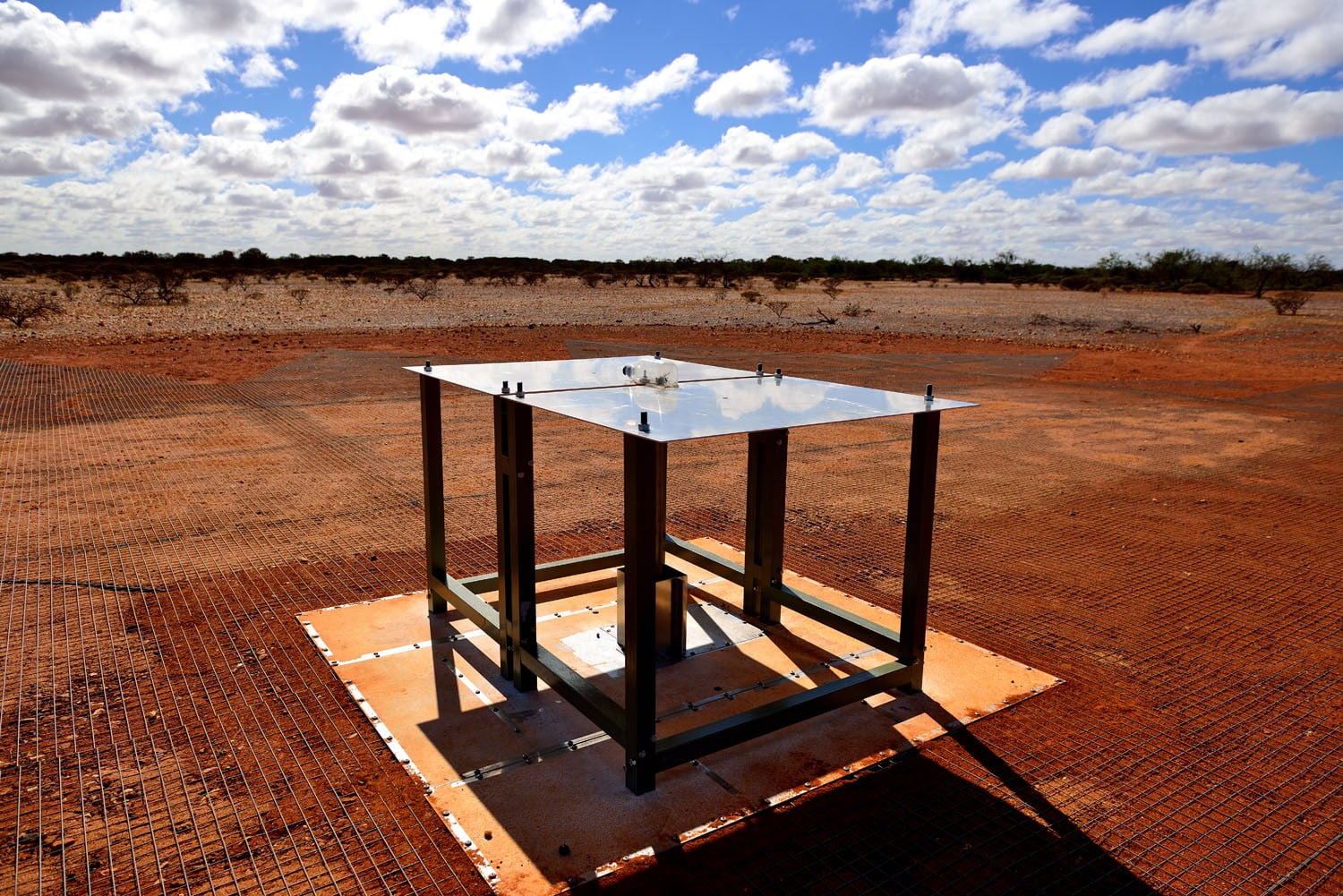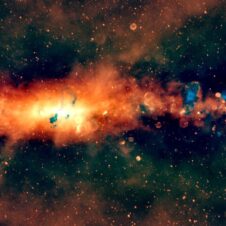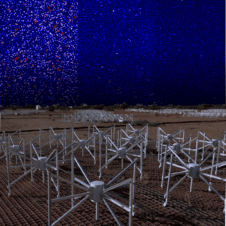Using a small radio telescope at a CSIRO observatory in Western Australia, US astronomers have detected a signal from the first stars to have emerged in the early Universe about 180 million years after the Big Bang.
The discovery is reported in the journal Nature today.
After the Big Bang, the Universe cooled and went dark for millions of years. In the darkness, gravity pulled matter together until stars formed and burst into life, bringing the ‘cosmic dawn’. This new-found signal marks the closest astronomers have seen to that moment.
“Finding this miniscule signal has opened a new window on the early Universe,” lead author Dr Judd Bowman of Arizona State University said.
(See explanatory video).
Dr Bowman has been running his Experiment to Detect the Global EoR (Epoch of Reionization) Signature (EDGES) for 12 years. Nine years ago he started doing the observations from the Murchison Radio-astronomy Observatory (MRO), after searching for the best place on the planet for this work.
The radio signal Dr Bowman’s team found was incredibly faint, coming from 13.6 billion years back in the Universe’s history. It also fell in the region of the spectrum used by FM radio stations, making detection of this weak signal from most Earth-based sites impossible.

In each instrument, radio waves are collected by an antenna consisting of two rectangular metal panels mounted horizontally on fiberglass legs above a metal mesh. The EDGES detection required the radio quietness at the Murchison Radio-astronomy Observatory, as Australian national legislation limits the use of radio transmitters near the site. This discovery sets the stage for follow-up observations with other powerful low-frequency facilities, including HERA and the forthcoming SKA-low. Photo Credit: CSIRO Australia / Bfrett Hiscock CSIRO Australia / Lou Puls CSIRO Australia
The MRO observatory is in a naturally extremely ‘radio-quiet’ location. This unique characteristic is protected by a legislated ‘radio quiet’ zone up to 260 km across, which keeps human-made activities that produce interfering radio signals to an absolute minimum.
The MRO’s development was managed by Antony Schinckel, CSIRO’s Head of Square Kilometre Array Construction and Planning.
“Finding this signal is an absolute triumph, a triumph made possible by the extreme attention to detail by Judd’s team, combined with the exceptional radio quietness of the site,” Schinckel said.
“We worked hard to select this site for the long-term future of radio astronomy after exhaustive investigations across the country. We believe we have the gold standard in radio quietness, the best site in the world.”
Mr Schinckel noted the experiment was extremely difficult.
“This is one of the most technically challenging radio astronomy experiments ever attempted. The lead authors include two of the best radio astronomy experimentalists in the world and they have gone to great lengths to design and calibrate their equipment in order to have convincing evidence for a real signal,” Mr Schinckel said.
Dr Robert Braun, Science Director at the SKA Organisation, said “This is a powerful demonstration of what can be achieved with the combination of an excellent site and world-class engineering, boding well for the great discoveries that will be enabled by the SKA.”

In each instrument, radio waves are collected by an antenna consisting of two rectangular metal panels mounted horizontally on fiberglass legs above a metal mesh. The EDGES detection required the radio quietness at the Murchison Radio-astronomy Observatory, as Australian national legislation limits the use of radio transmitters near the site. This discovery sets the stage for follow-up observations with other powerful low-frequency facilities, including HERA and the forthcoming SKA-low. Photo Credit: Judd Bowman (ASU)
The MRO was developed by CSIRO for its Australian Square Kilometre Array Pathfinder (ASKAP) telescope and also hosts a low-frequency telescope, the Murchison Widefield Array, developed by an international collaboration, led by Curtin University.
These telescopes make use of the radio-quiet nature of the site and also are important precursors to the Square Kilometre Array itself. It is now the Australian site for the low-frequency telescope of the future Square Kilometre Array, SKA-low.
– Ends –
From Professor Peter Quinn, Executive Director of ICRAR (UWA)
This paper by Judd Bowman and colleagues, on the detection of an all-sky signal from the first stars, represents a landmark moment for astronomy. Over the past 50 years, our knowledge of the mechanics of the Universe (cosmology) has gone from being mostly educated guesses to a precision science. This progress was made possible by a small number of fundamental discoveries using extraordinary instruments on the ground and in space. In 1964, Arno Penzias and Robert Wilson, using an antenna intended for telecommunications studies, discovered the faint all sky radio echo of the Big Bang that occurred 13.8 billion years ago. Some 28 years later, the COBE satellite was able to map this all sky signal and show for the first time the tiny ripples in the matter content of the Universe that grew since the Big Bang into the galaxies and stars we see today. Both these discoveries were awarded Noble Prizes (in 1992 and 2006 respectively) underscoring their fundamental importance for cosmology and our understanding of the Universe. The all-sky signal detected by Bowman and colleagues is another such breakthrough.
Their discovery now identifies that time in the Universe’s history when the first stars were formed. The location of that event, its duration and its subsequent end due to the heating of the Universe from these first stars, are new data that will further refine our knowledge of the Universe and the complex processes associated with star formation, galaxy formation and the nature of other major components of the Universe, like Dark Matter. The next step is to try to map the signal detected by Bowman in a similar manner to COBE mapping the signal detected by Penzias and Wilson. These maps will identify the locations of the places where stars were born and thereby enable us to discover the processes of star formation and ultimately galaxy formation. There are already telescopes around the world preparing to make these maps based on the breakthrough of Bowman and his team. That breakthrough would not have been possible with observations from the middle of a crowded city or even a small town. The radio noise generated by people, and civilization in general, completely swamps the tiny signals in the low frequency part of the spectrum from the Universes’ first stars. The isolation of the Murchison Radio-astronomy Observatory (MRO) in Western Australia gives it a very clear view of the low frequency radio sky and it is the home base for Bowman’s instrument. This new observatory, supported by the Australian Federal Government and the Government of Western Australia and operated by CSIRO, is also home to the Murchison Widefield Array (MWA) and will be the site for the low frequency component of the Square Kilometre Array (SKA). Both MWA and SKA are planning to construct maps of the sky to follow-up the major discovery that Bowman and his colleagues have made.
From Professor Steven Tingay, Deputy Executive Director of ICRAR (Curtin University)
In this paper in Nature, Bowman et al. describe the detection of radio wave signals from the early Universe that trace the formation of the first stars. These observations give us a fundamental insight into how matter in the Universe was evolving with surprising rapidity, only 200 million years after the Big Bang. The Big Bang was 13.8 billion years ago. If the age of the Universe is expressed as a human lifetime, Bowman et al. are looking at the Universe when it was the equivalent of a baby starting to walk (~1 year old). The evidence Bowman et al. have presented has been keenly sought by astrophysicists around the world for the last decade, making this a breakthrough result. In Australia, as part of an international consortium, we are currently developing the $1B Square Kilometre Array (SKA) radio telescope, which has the detailed investigation of these signals as its highest priority science case. These results (and the predictions reported in the companion Nature paper by Barkana) are therefore incredibly welcome news for Australian and international radio astronomy. Currently in Australia we are using a precursor to the SKA, the Murchison Widefield Array (MWA), to take the next steps beyond the results of Bowman et al., toward the SKA. The MWA and the instrument Bowman et al. use are located together in Western Australia, where the SKA will be built in the future. We will be looking for confirmation of the Bowman et al. results from other instruments and this is sure to accelerate the international competition to obtain more detailed data.
Professor Lister Staveley-Smith, Science Director (ICRAR/UWA)
The signal detected by Bowman and collaborators is remarkable in its strength. So strong in fact that it doesn’t fit well with expectations of the current cosmological model. If the signal is confirmed by other experiments (which may be relatively straightforward), the implications for our understanding of the evolution of the Universe and the nature of cosmic dark matter will be profound. Moreover, detailed observations with future radio telescopes, such as the low-frequency portion of the Square Kilometre Array (due to be constructed in Western Australia) will yield images of the distant Universe at times much closer to the Big Bang than originally thought. A truly amazing result.

